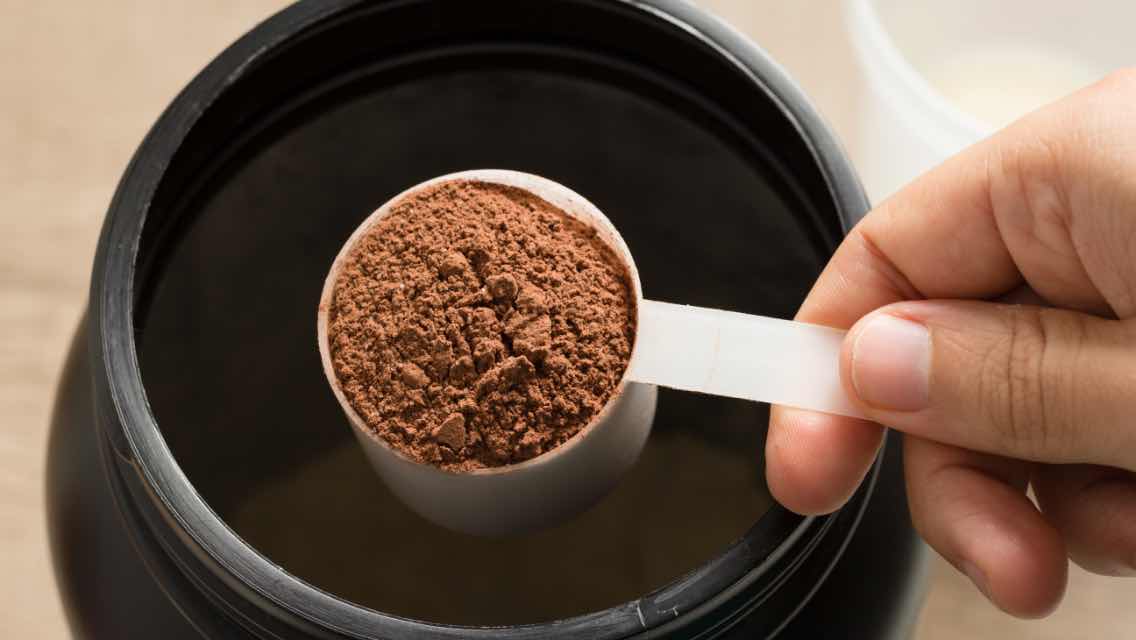Our bodies are quite literally made of protein. To build every structure and tissue — muscles, skin, hair, bones, blood cells, and organs included — we need the amino acids delivered by protein. And whey is an incredible source of these nutrients.
Protein itself is composed of long chains of amino acids. Our bodies digest proteins into shorter and shorter amino acid chains, eventually absorbing them into the bloodstream as individual amino acids.
Of the 20 amino acids that exist, nine are deemed “essential” because they can’t be produced by the body — we must consistently get them through food or supplementation. If we’re not consuming enough protein sources or essential amino acids, our bodies will “steal” them by breaking down other tissues in the body. Over time, this can affect the health of these structures — tissues or organs.
At Life Time, our team of dietitians generally recommend that people aim for 1 gram of protein per pound of lean body mass per day — this isn’t just our opinion, it’s rooted in scientific evidence on active, athletic populations seeking optimal health, strength, and a functional lifespan. This target may be a challenge for some to achieve through food alone, which is where a protein supplement, like whey protein, can come into play as a useful resource.
What is whey protein?
Whey protein is a byproduct of cheesemaking: Milk from cows is treated with enzymes and separated into curds and whey liquid. That liquid can be isolated, spray dried into a powder, and then processed to create a whey protein supplement. The further you take this liquid from milk to the end product determines the type of whey protein you’re going to get out of the whey liquid.
What is the difference between whey concentrate and whey isolate?
Milk is mostly made of water, but it also contains protein, including casein (the primary protein that gets made into cheese) and whey (the primary protein of the excess liquid). Milk also contains some carbohydrates — mainly in the form of lactose — and fat.
If you don’t process the whey liquid very much, you get whey concentrate, which is typically between 70 to 85 percent protein by weight. The rest of the weight is leftover carbohydrates and fats.
Additional filtering can further concentrate the protein, resulting in whey isolate. This raises the protein content to upward of 90 percent by weight and decreases the lactose and fat content.
Do the health benefits vary between whey concentrate and whey isolate?
Whey in either form offers a boost in protein, which can provide many health benefits. Among them is muscle protein synthesis, or the repair and building of lean muscle tissue. There’s very little difference in this result whether you consume whey concentrate or isolate or even casein.
Whey concentrate: This option provides a source of fats and carbohydrates alongside the high-quality protein. And because it’s minimally processed, it can also contain lactoferrin and immunoglobulin proteins, which can support immune health; other protein fractions that remain may also help with gut function.
Whey isolate: This is a good option for those who don’t tolerate lactose very well or who don’t want to consume extra calories from carbohydrates or fat. Whey isolate can also get into the bloodstream quickly, which can be helpful after a hard workout when your muscles are damaged and you need to get repair materials into them quickly.
How important is the quality of the whey protein?
Protein quality matters a lot. The whey concentrate products in Life Time’s LTH line, which includes LTH Whey Protein and LTH Build Whey+ All-in-One, are sourced from 100-percent grassfed cows from New Zealand. When an animal is grassfed (or grazing on pasture and consuming their natural diet of grasses) they tend to have better overall health and produce more nutritious milk.
The fat in grassfed, pasture-raised cow milk also tends to have a higher percentage of omega-3 fats, as well as a higher percentage of conjugated linoleic acid, which is a metabolically beneficial type of fat. The lactoferrin in the immunoglobulin proteins also tends to be in higher concentrations versus in feedlot animals. Some people would argue the flavor is unmatched as well.
Because the lactose, fats, and pretty much all the nutrients other than the amino acids are stripped out of whey isolate, it doesn’t necessarily matter (nutritionally) whether it’s sourced from grassfed cows. For our LTH Flex Whey Protein Isolate, we source from domestic, non-GMO, nonhormone-treated cattle; the end-product is upward of 90 percent protein by weight, so there’s very little of anything else in it. We know from laboratory analysis that each 20-gram protein serving size has less than 0.5 grams of lactose and no fat.
Avoid protein powders that contain added sugars or artificial sweeteners; instead, look for products that use natural flavors and natural sweeteners like stevia or monk fruit. Ideally, you also want to opt for a product that is third-party tested. LTH products are tested for identity, purity, potency, and contaminants before production and prior to release from the manufacturer. LTH protein powders are also independently certified by NSF. (Learn more: “What Is NSF Testing for Supplements?”)
What’s the bottom line?
From my point of view, the best all-around protein powder option is a whey concentrate — like LTH Whey Protein— if you can tolerate a few grams of lactose. It’s the best “whey” to boost protein in your morning smoothie, oatmeal, or yogurt parfait. If you want a protein-packed, just-add-liquid meal replacement option with additional vitamins, minerals, fiber, probiotics, and digestive enzymes, consider LTH Build Whey+ All-in-One.
If you do not tolerate lactose well or prefer an option with a higher amount of protein by weight, then a whey isolate like LTH Flex Whey Protein Isolate is the best choice.





